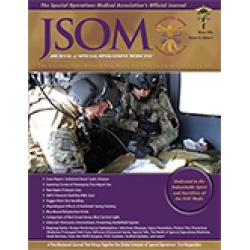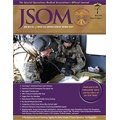Significant Pressure Loss Occurs Under Tourniquets Within Minutes of Application
Rometti MR, Wall PL, Buising CM, Gildemaster Y, Hopkins JW, Sahr SM 16(4). 15 - 26 (Journal Article)
Background: Pressure decreases occur after tourniquet application, risking arterial occlusion loss. Our hypothesis was that the decreases could be mathematically described, allowing creation of evidence-based, tourniquet-reassessment- time recommendations. Methods: Four tourniquets with width (3.8cm, 3.8cm, 13.7cm, 10.4cm), elasticity (none, none, mixed elastic/nonelastic, elastic), and mechanical advantage differences (windlass, ratchet, inflation, recoil) were applied to 57.5cm-circumference 10% and 20% ballistic gels for 600 seconds and a 57.5cmcircumference thigh and 31.5cm-circumference arm for 300 seconds. Time 0 target completion-pressures were 262mmHg and 362mmHg. Results: Two-phase decay equations fit the pressure-loss curves. Tourniquet type, gel or limb composition, circumference, and completionpressure affected the curves. Curves were clinically significant with the nonelastic Combat Application Tourniquet (C-A-T), nonelastic Ratcheting Medical Tourniquet (RMT), and mixed elastic/nonelastic blood pressure cuff (BPC), and much less with the elastic Stretch Wrap And Tuck-Tourniquet (SWATT). At both completion-pressures, pressure loss was faster on 10% than 20% gel, and even faster and greater on the thigh. The 362mmHg completion-pressure had the most pressure loss. Arm curves were different from thigh but still approached plateau pressure losses (maximal calculated losses at infinity) in similar times. With the 362mmHg completion-pressure, thigh curve plateaus were -68mmHg C-A-T, -62mmHg RMT, -34mmHg BPC, and -13mmHg SWATT. The losses would be within 5mmHg of plateau by 4.67 minutes C-A-T, 6.00 minutes RMT, 4.98 minutes BPC, and 6.40 minutes SWATT and within 1mmHg of plateau by 8.18 minutes C-A-T, 10.52 minutes RMT, 10.07 minutes BPC, and 17.68 minutes SWATT. Timesequenced images did not show visual changes during the completion to 300 or 600 seconds pressure-drop interval. Conclusion: Proper initial tourniquet application does not guarantee maintenance of arterial occlusion. Tourniquet applications should be reassessed for arterial occlusion 5 or 10 minutes after application to be within 5mmHg or 1mmHg of maximal pressure loss. Elastic tourniquets have the least pressure loss.


 English
English 




